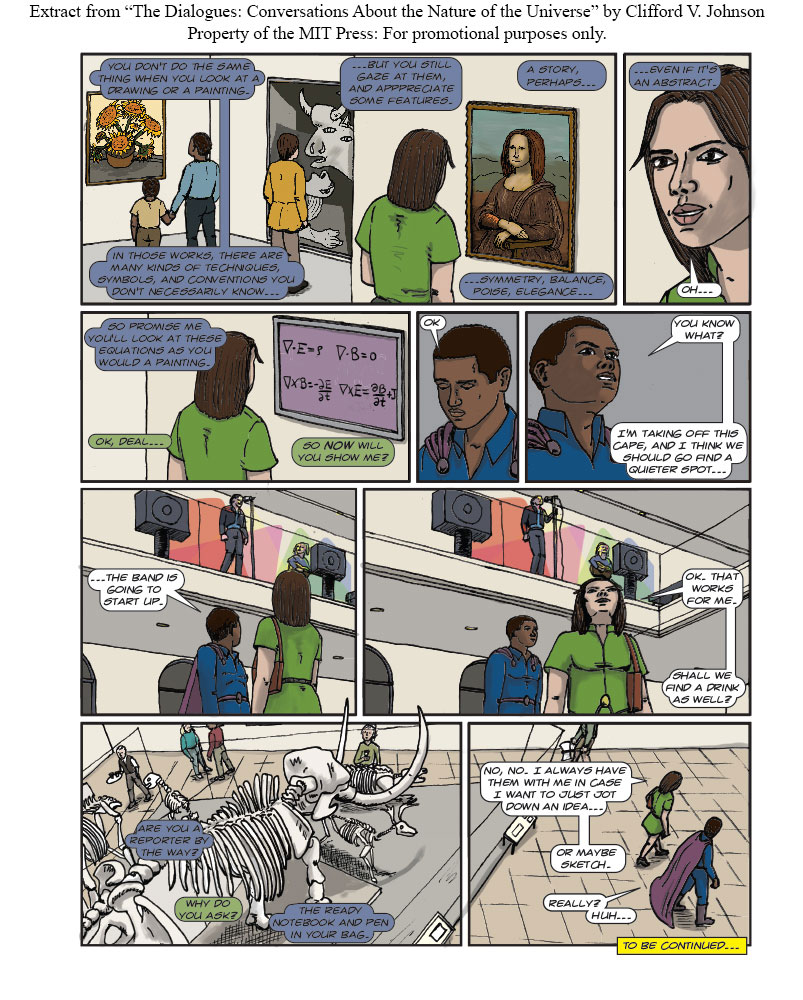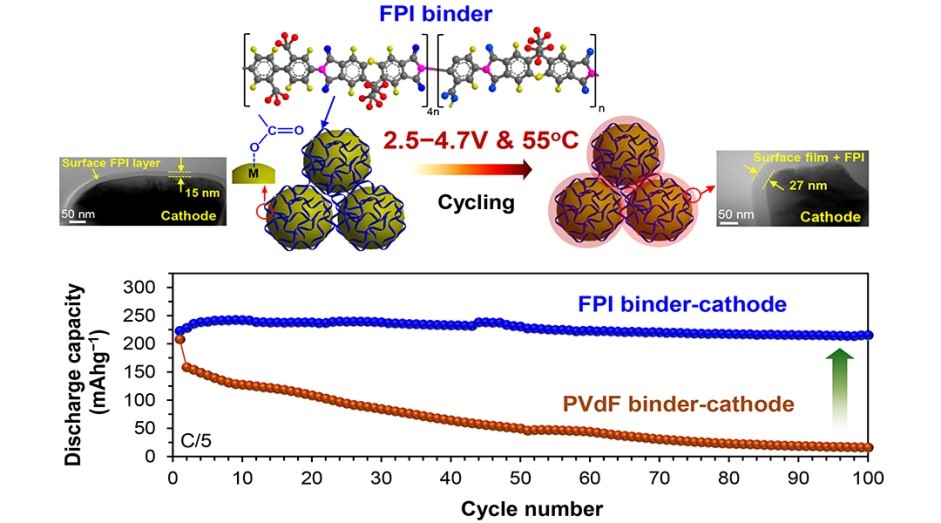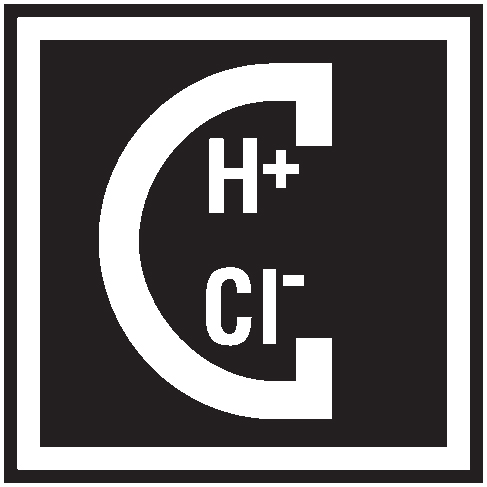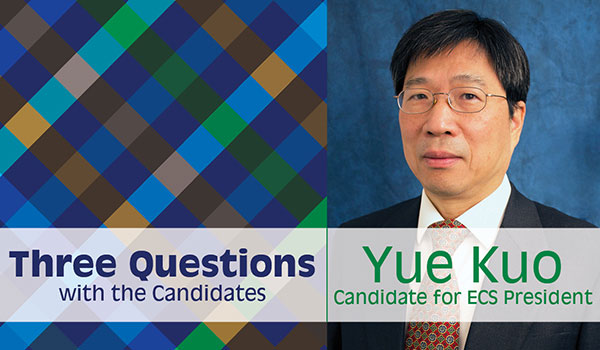 The ECS Transactions (ECST) enhanced issues for the 233rd ECS Meeting in Seattle, WA, have just opened to submissions.
The ECS Transactions (ECST) enhanced issues for the 233rd ECS Meeting in Seattle, WA, have just opened to submissions.
The following Seattle symposia will be publishing enhanced issues of ECST:
 The ECS Transactions (ECST) enhanced issues for the 233rd ECS Meeting in Seattle, WA, have just opened to submissions.
The ECS Transactions (ECST) enhanced issues for the 233rd ECS Meeting in Seattle, WA, have just opened to submissions.
The following Seattle symposia will be publishing enhanced issues of ECST:
By: Clifford Johnson, University of Southern California – Dornsife College of Letters, Arts and Sciences

Science is one thread of culture – and entertainment, including graphic books, can reflect that. ‘The Dialogues,’ by Clifford V. Johnson (MIT Press 2017), CC BY-ND
How often do you, outside the requirements of an assignment, ponder things like the workings of a distant star, the innards of your phone camera, or the number and layout of petals on a flower? Maybe a little bit, maybe never. Too often, people regard science as sitting outside the general culture: A specialized, difficult topic carried out by somewhat strange people with arcane talents. It’s somehow not for them.
But really science is part of the wonderful tapestry of human culture, intertwined with things like art, music, theater, film and even religion. These elements of our culture help us understand and celebrate our place in the universe, navigate it and be in dialogue with it and each other. Everyone should be able to engage freely in whichever parts of the general culture they choose, from going to a show or humming a tune to talking about a new movie over dinner.
Science, though, gets portrayed as opposite to art, intuition and mystery, as though knowing in detail how that flower works somehow undermines its beauty. As a practicing physicist, I disagree. Science can enhance our appreciation of the world around us. It should be part of our general culture, accessible to all. Those “special talents” required in order to engage with and even contribute to science are present in all of us.
So how do we bring about a change? I think using the tools of the general culture to integrate science with everything else in our lives can be a big part of the solution.
A new water-based air-conditioning system cools air to as low as 18 degrees Celsius (about 64 degrees Fahrenheit) without using energy-intensive compressors and environmentally harmful chemical refrigerants.
This technology could potentially replace the century-old air-cooling principle that is still used in modern-day air-conditioners. Suitable for both indoor and outdoor use, the new system is portable and can be customized for all types of weather conditions.
The team’s novel air-conditioning system is cost-effective to produce, and it is also more eco-friendly and sustainable.
 Incorporating organic electronic materials in the field of bioelectronics has indicated promising potential in interfacing with biological systems, including neuroscience applications. Researchers from Linköping University are taking a major step forward in that work with their development of the world’s first complementary electrochemical logic circuits that can function for long periods of time in water.
Incorporating organic electronic materials in the field of bioelectronics has indicated promising potential in interfacing with biological systems, including neuroscience applications. Researchers from Linköping University are taking a major step forward in that work with their development of the world’s first complementary electrochemical logic circuits that can function for long periods of time in water.
While the first printable organic electrochemical sensors appeared as early as 2002, significant advancements have developed in a few years. Organic components such as light-emitting diodes and electrochemical displays are already commercially available.
This from Linköping University:
The dominating material used until now has been PEDOT:PSS, which is a p-type material, in which the charge carriers are holes. In order to construct effective electron components, a complementary material, n-type, is required, in which the charge carriers are electrons.
 A team of researchers from the University of Toronto is looking to give wasted materials new value by developing a new catalyst that could help recycle carbon dioxide into plastic.
A team of researchers from the University of Toronto is looking to give wasted materials new value by developing a new catalyst that could help recycle carbon dioxide into plastic.
According to a new study, the researchers have successfully used a new technique to efficiently convert carbon dioxide to ethylene, which can then be processed to make polyethylene, the most common plastic used in making packaging, bottles, and toys.
By using a copper catalyst, the team was able to achieve the desired result of ethylene production. However, controlling the catalyst was one of the technological challenges the team had to overcome.

Superior high-voltage performance of Li-ion full cell with Li-rich layered oxide cathode prepared with fluorinated polyimide (FPI) binder, compared to the cell with conventional binder PVdF. (Click to enlarge.)
Image: Seung Wan Song
In order to increase the driving range of electric vehicles, researchers across the globe are working to develop lithium-ion batteries with higher energy storage. Now, scientists at Chungnam National University and Kumoh National Institute of Technology in Korea are taking a step toward that goal with their development of the first high-voltage cathode binder for higher energy Li-ion batteries.
Today’s Li-ion batteries are limited to charge to 4.2V due to the electrochemical instability of the liquid electrolyte and cathode-electrolyte interface, and loosening of conventional binder, polyvinylidenefluoride (PVdF), particularly at elevated temperatures. The fabrication of Li-rich layered oxide cathode with a novel high-voltage binder, as the research team demonstrated, can overcome these limitations.
Charging the batteries with Li-rich layered oxide cathode (xLi2MnO3∙(1−x)LiMO2, M = Mn, Ni, Co) to higher than 4.5V produces approximately doubled capacity than those with LiCoO2 cathode, so that doubled energy density batteries can be achieved.
A new method to quickly produce fibers from carbon nanotubes is both handmade and high tech.
The method allows researchers to make short lengths of strong, conductive fibers from small samples of bulk nanotubes in about an hour.
In 2013, Rice University chemist Matteo Pasquali found a way to spin full spools of thread-like nanotube fibers for aerospace, automotive, medical, and smart-clothing applications. The fibers look like cotton thread but perform like metal wires and carbon fibers.
 Do you know of an organization that is hiring? Are you connected with recruiters or managers looking to fill positions? You now have a unique opportunity to help ECS work towards engaging employers through our ECS Career Expo.
Do you know of an organization that is hiring? Are you connected with recruiters or managers looking to fill positions? You now have a unique opportunity to help ECS work towards engaging employers through our ECS Career Expo.
The ECS Career Expo is being hosted at the 233rd ECS Meeting in Seattle, WA from May 14-16, 2018 in the exhibit hall. Hiring managers and recruiters are able to showcase their organizations to more than 2,000 anticipated meeting attendees in an exclusive exhibit booth area.
The ECS Career Expo helps to support the mission of ECS in advancing the science. Take a moment and send recruiter or hiring manager contact information to Shannon Reed, director of membership services: Shannon.Reed@electrochem.org.
 Extended deadline: February 12, 2018
Extended deadline: February 12, 2018
On behalf of the ECS Corrosion Division, you are invited to nominate qualified candidates for the following award:
Herbert H. Uhlig Award was established in 1972 to recognize excellence in corrosion research and outstanding technical contributions to the field of corrosion science and technology. The award consists of a framed certificate and a $1,500 prize. The next award winner will be recognized at the 234th ECS Meeting, as part of AiMES 2018, which takes place in Cancun, Mexico September 30 – October 4.
The 2017 winner of this award was Herman Terryn of Vrije Universiteit Brussel Belgium who presented an award talk called Advanced Experimental and Modelling Approaches to Understand and Predict Better Corrosion of Metals.
 The 2018 Society elections are upon us and ECS wants you to learn more about the candidates from the candidates.
The 2018 Society elections are upon us and ECS wants you to learn more about the candidates from the candidates.
The early months of each year are an exciting time here at ECS as officer elections take place via electronic proxy in the two-month period from January 15 to March 15, 2018. Elected officers constitute the organization’s executive committee and include the following positions: president, three vice presidents, secretary and treasurer. The nominating committee determines the candidates and you determine the winner.
Three Questions with the Candidates allows you a personal glimpse of each volunteer on the current ballot. There is a total of five candidates (one for president and two each for vice president and treasurer). Take a moment to read the full candidate biography and election statement. And then enjoy their reflections on ECS and the marvel that is science.